The fungus of nails on the legs is a common pathology, which is accompanied by unpleasant symptoms: shrinkage or stratification of nail plate, a change in shadow, pain, itching and other negative sensations.What are the causes of the disease, what types and internships are they?How to diagnose and eliminate damage to the nail plate?Is it possible to alert the pathological process?
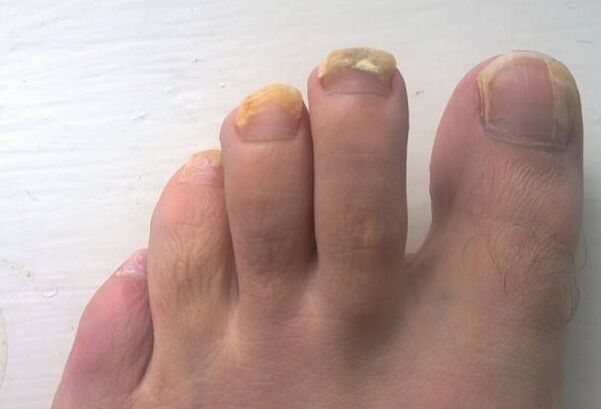
What is onicomicosis, why reasons arise
Nail fungus on the legs or onychomycosis is a disease caused by dermatophytes, mold, yeast and other varieties of mushrooms.This is a secondary infection that occurs after feet skin lesions.
The main factors that affect the development of pathology:
- age and sex of man;
- weather conditions;
- concomitant diseases;
- profession.
The disease can occur for the following reasons:
- Moisture contributes to the rapid spread of the fungus, especially if a person neglects the drying of shoes;
- Visit a bath, pool, a common soul without personal shoes, walking with bare feet;
- non -compliance with elementary hygiene rules;
- enter a favorable environment of dried fungus particles, which are on the skin;
- Endocrine system pathologies, metabolic disorders;
- Foot deformation and circulatory violation in it;
- Using the inconvenient and inappropriate size.
Varieties of the fungus and its resources
There are 3 main types of onychomycosis:
- Normotorophic.This type is characterized by a change in the shadow of nails, the appearance of stripes and spots from white to yellowish.The brightness and strength of the nail plate are preserved.
- Hypertrophic.The tone of nails is changing - they become opaque, thicker and partially destroyed.Often patients with this disease are painful to walk.
- Onical.The nail plate is intensely spotted in gray and gradually rejected by the surrounding tissues.

Varieties of onychomycosis at the injury site:
- distal (nail is affected on the free edge);
- Lateral - damage to places on the sides;
- Proximal - the rear roll is affected;
- Total - The whole nail plate suffers from the disease.
The stages of onychomycosis, symptoms that accompany you
The nail fungus on the legs does not defeat the phalanx immediately and completely, the disease gradually goes through various stages:
- early (initial);
- Launched (afternoon).
At the beginning of a fungal disease, after a violation of the integrity of the feet, there are sensations of itching between the fingers, cracks and bubbles appear.Gradually, the infection affects different parts of the nail.In most situations, at an early stage, pathology cannot be diagnosed independently due to lack of pronounced symptoms.Small stripes and other people interspersed with nail plate are virtually not visible to the naked eye.Laboratory diagnoses are shown.
The advanced stage is a broad damage to the nail and the part of the whole phalanx.In the absence of timely treatment, there is a complete loss of nail plate, impaired skin integrity and the transition of harmful microorganisms that caused the infectious process to the hands.
The main symptoms of the late stage of the pathology: detachment and shrinkage of nail plate, violation of its shape and thickness.The last stage of the disease is the complete destruction of the nail or its pronounced deformation, as well as the development of complications under the influence of a fungus that requires long and complex therapy.

Diagnostic methods
To diagnose onicomycosis, you should contact a dermatologist.The doctor will prescribe laboratory studies (microbiological and histological), evaluate the results of tests, symptoms and conduct a patient research and examination.
Therapeutic tactics depend on the severity of the disease, its causes, concomitant symptoms and the type of pathogen.The diagnosis is confirmed or refuted when using light wood light bulb.The differential diagnosis is made to distinguish between the fungus from other diseases (psoriasis, eczema, flat red lichen, etc.).
Treatment Characteristics
Any fluctuations in the appearance of nails (persistent and slowly progressive) in shape, color, thickness and structural characteristics are the reason for contacting the dermatologist immediately.The sooner the patient begins local treatment, the lower the likelihood that the use of funds for oral use, which acts broadly in all body systems, will be necessary.
Popular remedies have proven their effectiveness in the early stages of onychomycosis, and their use is well -being -by doctors.However, all procedures, drug treatment and folk therapy should be agreed with the assistant doctor according to the results of the laboratory and hardware research, studying anamnesis and evaluating concomitant symptoms.
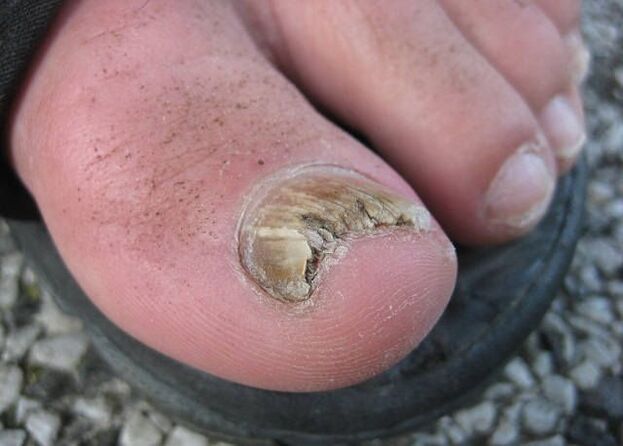
External use
If the disease begins to develop actively and has not reached the final stages with severe symptoms, we can be limited to the application of local antifungal medications.It is enough to apply a cream, gel or solution by pathological area a few times a day, morning and night.
Prior to local medicine application, it is necessary to prepare nail plates first.First of all, you need to dive your feet into a cafeteria solution (in a half -full pelvis with hot water, 1 tablespoon and 50 g of laundry soap should be dissolved).Thanks to a 15 -minute bath, the nail layers are significantly softened, which should be removed with scissors or manicure tips and fired with a file.
When processing, you should not use the same manicure devices for simultaneous care for patients and healthy nails.
In the early stages of fungal damage, you can use special antifungal varnishes.The duration of therapy is about a year.
Oral preparations
If the disease has passed at the early stage and develops every day, oral use of drugs in a tablet form is indicated.Such medications help overcome the disease, even in the most advanced stages.Penetrating the blood, the active components of the drugs comprehensively affect all body systems, which does not allow the fungus to penetrate the healthy organs.
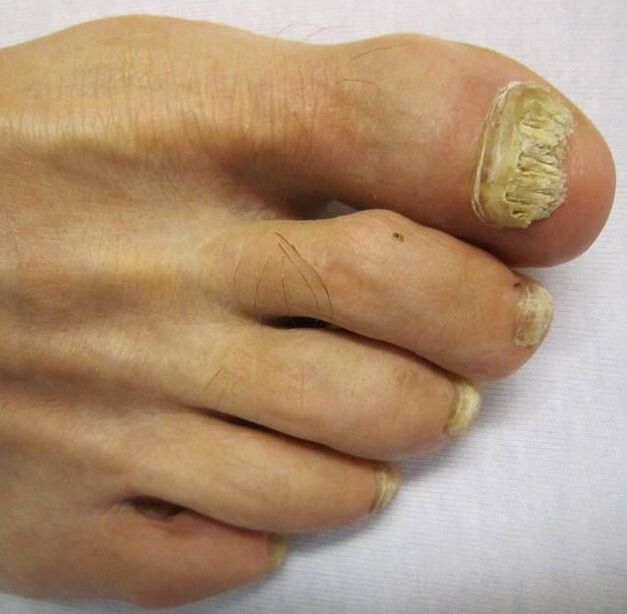
Fissoalization
An effective method of physiotherapeutic treatment is a laser therapy.However, to obtain a persistent effect of laser therapy, this procedure is shown in combination with medicines - laser is not able to kill independently the fungus without a pharmacy.Laser therapy helps prevent the disease from relapse due to the penetration of the lightning in the deeper layers of the skin, reaching distant outbreaks of the lesion.
With advanced forms of onychomycosis, electrochemical methods of physiotherapeutic effects are effective.These are procedures such as electrophoresis and onophoresis.Physiotherapy helps penetrate affected areas of the skin and the destruction of other varieties of fungi.
Surgical removal of the nail plate
Many experts recommend surgical removal of the nail plate damaged by a fungus if the disease is at an advanced stage, while other methods have demonstrated its inefficiency.The operation is performed in an outpatient or hospital with preliminary anesthesia.
Possible complications after surgical intervention:
- pain;
- penetration of infection in the wound;
- Additional growth of nails irregularly.
Surgical intervention is against -Indicated in people:
- with slowly healing wounds;
- having lameness;
- With poorly filled with blood confirmed by diagnostic studies.
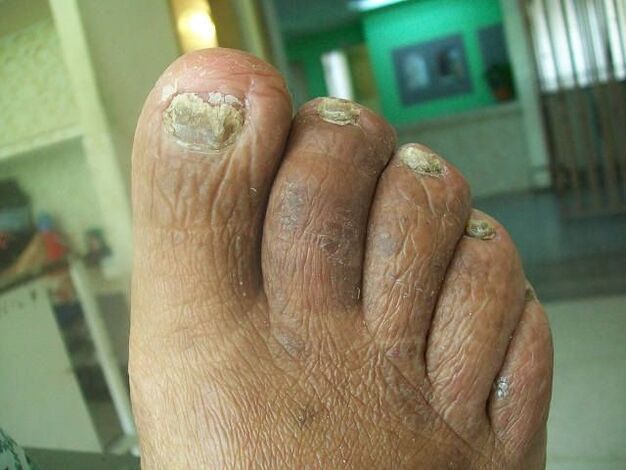
Recommendations after the operation:
- Do not carry your fingers for several days;
- Do not fall for the bandage for a week;
- Avoid tight shoes;
- Regularly treat the wound with an anti -space, make sauces;
- Periodically visit a dermatologist to evaluate the quality of treatment and prevent the relapse of the disease.People's means
Even experts receive treatment with folk medicine.The main condition is a preliminary consultation with the assistant doctor to calculate dosages and receive recommendations.
Effective popular remedies for nail fungi:
- Vinegar.Harmful microorganisms that cause a pathological process die in an acid environment.It is enough to make vinegar baths daily (water at room temperature with vinegar in a ratio of 8: 1) for 15 minutes.Before the procedure, you should vaporize your legs.
- Propolis.The tool is effective only with systematic use.You should take a 25%bee glue dye, moisten a cotton pillow, attach to the pathological site and fix the gauze dressing at night.
- Iodine.This is the simplest and most effective method of treating the fungus of nail plates.In well -washed and dried nails, the iodine should be applied with a cotton swab, affecting only the damaged nail area.Therapy should last about a month.
- Refrigerator.In 2 liters of warm water, 1 tablespoon should be dissolved.l.refrigerator.In this bath, you need to keep your legs for about 15 minutes.
- Essential oils.The highest efficiency was demonstrated by tea tree oil.The substance should be rubbed on the damaged nail plate 2 times daily for at least 3 weeks.
- Herbal -based products.The most effective are the following herbs: Celandine, thyme, bardan, gold mustache.
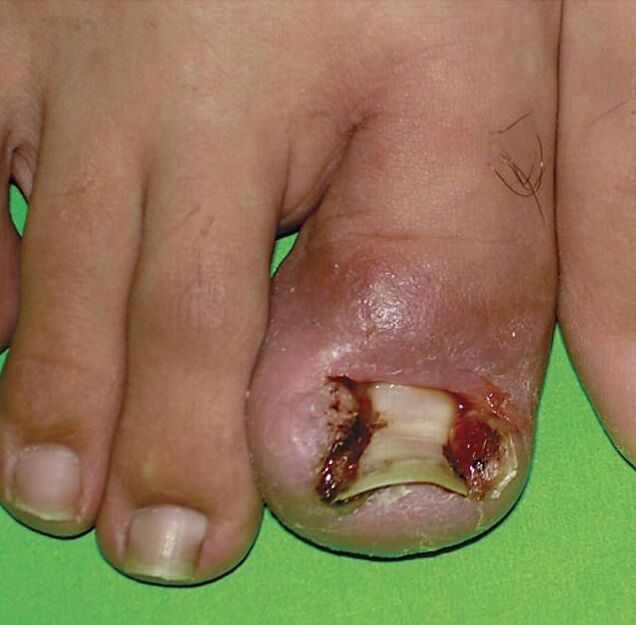
Errors in treatment and their consequences
3 common errors made by many patients during the treatment of onychomycosis:
- incorrectly prescribed medicines;
- Outdated approach to treatment;
- Failure to comply with preventive measures to prevent infection.
The fungus of nails on the legs with insufficient treatment or its absence can cause eczema, lympostase, the connection of a bacterial infection with the development of inflammation, the complete loss of nail plate, the inflammatory process at the lower ends and other pathologies.If the fungal infection spreads throughout the nail plate, it is urgent to initiate treatment to avoid the appearance of complications.If the patient has a strong immunity and no pronounced symptoms of onychomycosis, the body is able to deal with infection without outside help.
Preventive measures
To avoid onicomycosis, it is necessary to adhere to the following rules:
- Wash your legs daily with warm water with soap or other skin washing;
- Use a stone -S or a special brush to remove layers of keratinized and dead skin;
- Clean the legs well after washing, paying special attention to the intervals between the fingers;
- Begin a separate leg towel, wash -regularly at high temperatures;
- Use talc and other cosmetics for intensive legs;
- Do not neglect the rules of personal hygiene, especially after physical and hot season;
- Choose comfortable shoes made of natural materials, which do not rub and compress the phalanxes of the toes;
- After wearing, giving shoes to dry out of moisture;
- Do not put socks and shoes on the wet legs;
- In the rain or snow, always change shoes, falling into a hot dry room.
The fight against nail fungus should start, armed with knowledge about it.Thanks to this selection, you can decide independently the pathogen, location and severity of onicomycosis and start taking some actions on time.
















